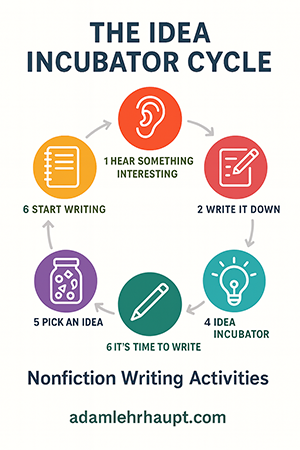If you’ve ever heard the dreaded student sigh: “I don’t know what to write about,” you’re not alone. Generating ideas for nonfiction writing activities can feel like pulling teeth…for students and teachers. But what if there were a simple, low-prep system that turns idea-hunting into an adventure instead of a roadblock?
Enter the Idea Incubator.
Inspired by children’s nonfiction author Melissa Stewart (who’s written more than 200 books!), this strategy helps students collect, nurture, and hatch writing ideas…so they’re always ready to dive into nonfiction writing activities with excitement instead of dread.
TL;DR
- The Problem: Kids freeze when asked to generate nonfiction topics.
- The Fix: Create an “Idea Incubator” – a notebook or bulletin board space where curiosities, fun facts, and questions are stored.
- The Payoff: Students never face a blank page. They write from passion, see research as a treasure hunt, and develop stronger nonfiction writing habits.
What Is an Idea Incubator?
Think of the Idea Incubator as a cozy little nest for curiosity. Anytime students encounter something fascinating, a surprising fact, a big “why” question, or even a random spark of wonder, they jot it down and save it in the incubator.
- In a writer’s notebook, it can live on the last page or inside the back cover.
- As a class display, it can be a bulletin board, a sticky-note wall, or even a digital Padlet.
When it’s time for nonfiction writing, students don’t start cold. They flip to their incubator, pick a spark, and watch it grow into a full-fledged piece.
Why Kids Need This (and Why Teachers Love It)
- It eliminates “I don’t know what to write about.” Every child has a personal stash of starting points.
- It fosters authentic research. Kids chase questions they actually care about, not just assigned topics.
- It connects passion to curriculum. Revolutionary War unit? Students with “weather” in their incubator can research snowy battles. A kid who loves fashion might explore soldiers’ uniforms. Instant engagement!
- It makes nonfiction writing activities joyful. Instead of slogging through reports, students feel like explorers piecing together a treasure map.
How to Set Up an Idea Incubator in Your Classroom
- Launch with Wonder. Share your own “idea board” or Idea Jar story. Tell kids that all writers, even professionals, collect sparks.
- Give It a Home. Have students label the final page of their notebook “My Idea Incubator.” Encourage them to decorate it with doodles, washi tape, or even “do not disturb” borders.
- Model Collecting Ideas. During read-alouds, science experiments, or even recess chat, pause to say:“That would be a great incubator idea. I’m writing it down!”
- Practice Feeding the Incubator. Do a five-minute “curiosity hunt.” Students jot down anything they wonder, notice, or find fun.
- Use It for Choice Writing. When students face nonfiction writing activities, reports, essays, or informational texts, have them pull from their incubator first.
- Celebrate Hatchlings. When an idea turns into a finished piece, let students move it from the incubator onto a “Hatched Ideas Wall” (instant motivation!).
Linking Passion to Curriculum
One of the smartest parts of this strategy is how it bridges student interest with teacher-required units.
For example:
- Science → A child curious about storms researches Revolutionary War weather.
- Art → A child fascinated by drawing explores how feathers inspire fashion.
- Food Studies → A budding chef investigates what soldiers ate during long marches.
Instead of dragging students through dry research, the incubator makes nonfiction writing activities feel like personal quests that still meet curriculum goals.
Helpful Background Reads
If you want to dive deeper into this approach, here are three resources worth bookmarking:
- Melissa Stewart’s Kids Love Nonfiction site – Packed with activities, classroom resources, and more details on the Idea Incubator.
- Adam Lehrhaupt’s Idea Jar – A playful picture book about ideas escaping and needing to be wrangled back through storytelling. Perfect for a launch activity!
- NCTE Nonfiction Position Statement – The National Council of Teachers of English outlines why nonfiction belongs at the heart of literacy instruction.
FAQ
How is this different from an “Idea Jar”?
An idea jar is a great tool, and can certainly be used with the incubator. The Idea Jar book is a launchpad for creative storytelling that illustrates what the incubator can accomplish. The Idea Incubator itself is a notebook-based strategy that takes the jar to the next step. Students keep their incubator notebook with them all year to generate and track nonfiction, or even fiction, ideas.
What if my students don’t add to it regularly?
Build “feed the incubator” moments into lessons. For example, after science experiments or read-alouds, give two minutes for incubator jotting. Make it fun and they’ll be more likely to add to it.
Can this work for younger grades (K–2)?
Yes! Younger students can draw pictures instead of writing words. Pair drawings with dictation or partner share-outs.
Conclusion
Nonfiction writing activities don’t have to start with a groan and end in frustration. With an Idea Incubator, students learn that ideas are everywhere, and that writing is a treasure hunt, not a chore.
So next time your students freeze at the blank page, remind them: “Check your incubator.” Chances are, they’ve already hatched their next great nonfiction piece.
And if you’d like an author to model how professional writers use strategies like this in real life, don’t forget: booking an author visit can be the spark that makes kids say, “Hey, I’m a writer too.”




